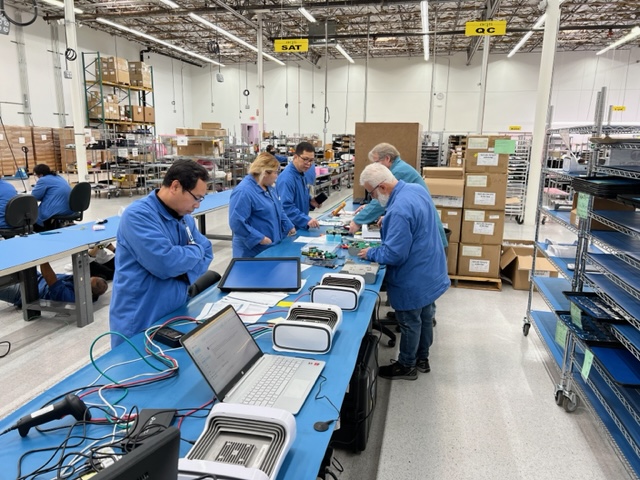Raising the Roof (on Network Capacity) – New “Indoor Backhaul” System to Help Meet Rapidly-Growing Bandwidth Requirements for IIoT Applications

The Industrial IoT market (IIoT) represents yet another area where digitization, AI-based industrial automation and high-speed connectivity are driving a revolution in factories and warehouses. This represents a major overhaul in operational efficiency and productivity and network bandwidth is the foundation of it all. However, invention is outpacing the infrastructure available as the cable plant that exists was installed years ago with a mission of connecting computers and maybe a VoIP system. This aging infrastructure is now being tasked with supporting 3D printing, AR/VR systems, CAD terminals and robotics being controlled by a centralized AI. All of this means “big data” is being moved around in real time.
Furthermore, the pandemic saw a huge increase in the size and number of warehouses while factories were pushed to the limits of Just In Time manufacturing. A single warehouse can have an area of more than 100,000 sq ft and require cable runs of thousands of feet to connect all the network gear installed there to provide connectivity. And factoring in the industrial manufacturing “footprint” with warehouse real estate results in a worldwide figure of more than 10 billion square feet of floor space needing connectivity.
There is potentially a lot of ground to cover here and facilities managers are looking at ways to upgrade the internal network connecting all of these high-bandwidth “points” within it – with lowering operational costs by improving speed and efficiency a prime objective. One impediment, however, is that these networks are deployed in harsh (when compared to offices, MDUs and hospitality facilities) environments with heavy machinery in constant motion. Laying new cable, or just re-routing existing cables can be challenging given the typical 16 to 24 hours of operation per day, which allows for only small time windows for network upgrades.
Taking inspiration from the “outside world,” where wireless technologies have often been deployed when wireline networks have needed upgrading (or deployed where there was no wireline infrastructure at all), a new method taking advantage of the “millimeter wave” 60 GHz frequency band, which offers plenty of bandwidth with virtually zero interference from other sources of radio emissions, has been developed to provide a faster, simple and secure high performance solution to connecting devices across the IIoT landscape.
Further, similar to how the traffic from cellular base stations is “backhauled” into high-capacity fiber networks, this new technological development represents the first “indoor” backhaul system and is well-suited for the needs of today’s IIoT environments. In addition, high-frequency systems like this typically operate on a point-to-point “line of sight” (LOS) basis, which can limit deployment flexibility. However, advances in what is called “radio front end” and “beam steering” technologies enable this system to offer “non” LOS connectivity.
In other words, the connections can snake around corners or penetrate most interior barriers – meaning they can go everywhere a cable could go, but with minimal construction work – no drilling, no sawing, no patching and painting over holes in walls, for instance. The network nodes can be deployed where they are needed connecting advanced machinery or Wi-Fi APs, not limited by hardwired, static cable locations.
This breakthrough capability greatly simplifies and expedites network set-up and operational readiness and trial deployments of this system have shown that a 100,000 square foot warehouse can be completely covered with this indoor backhaul system in days and at a fraction of the cost of running new CAT-6A Ethernet RJ-45 cable. These trials have also demonstrated the system’s effectiveness in complementing or retrofitting existing LANs or boosting the performance of legacy 1 Gb/s CAT-5 Ethernet cables.
Furthermore, with network security being top of mind everywhere these days, the “complementary” aspects of this new form of indoor connectivity present a golden opportunity to enhance network security. Specifically, indoor backhaul systems can be deployed as a companion network to existing wired infrastructure, enabling the complete segmentation of OT (operations traffic) and IT (information traffic) for maximum security. IT runs the business and OT runs the plant functions. A separate system allows IT departments and facility managers to control the connection between IT and OT. This connection can be firewalled and monitored to reduce the risk of hacking. Furthermore, separation helps optimize the IT and OT devices and services, as the networks' requirements and functions are different.
Conclusion: Most future enterprise application and device use will be indoors, often with a wireless connection. But whether the final link is over Wi-Fi, new private 5G networks or another technology, there will always need to be high-performance backhaul from the access point. Yet it is not always possible to use cable or fiber, as there may be walls, obstacles or simply a lack of skilled installers. New wireless technology addresses these problems – and helps improve overall indoor network flexibility and time-to-deploy.
Comments (0)
This post does not have any comments. Be the first to leave a comment below.
Featured Product

